Our eLearning development process plays a significant role in many of the L&D experiences we create—after all, our organization lives and breathes learning innovation. And while it’s often just one aspect of a more-comprehensive learning strategy, it’s an extremely important tool in any L&D toolkit.
But not all eLearning is created equally. The eLearning development process is both a technical art and a complex science. One that requires collaboration across teams, consistent checks and balances, and a range of resources. It also necessitates a long-term approach that accounts for not only conceptual creativity but also close attention to the details that make all the difference.
Here at Maestro, we’re the experts at creating amazing custom eLearning programs that create change. After 15 years in the L&D game, our approach to developing effective and inspired L&D programs is tried and true. Our incredible internal teams are pros at collaborating, brainstorming creatively in real-time, and finding learning solutions for even the toughest material. And as a result, our process is consistently top-notch, dialed in, and successful.
So whether you’re seeking inspiration for your own approach to the eLearning development process, or you’re curious about what it’s really like to partner with Maestro to develop an eLearning course, this article has you covered.
What’s in this article
We’ll give you an overview of the process, including the practices and principles that guide us through it. Then we’ll outline each stage of our process, detailing key steps and revealing how the magic happens.
What is the eLearning development process?
- Key players
- Practices and principles
Maestro’s step-by-step process
- Discovery and working session
- Outlining and storyboarding
- Design
- Development
- Reflection and delivery
What is the eLearning development process?
The process of developing an eLearning course is comprised of five key phases: the discovery and working session, outlining and storyboarding, design, development, and reflection and delivery phases.
This undertaking requires not only a step-by-step strategic approach, but also a collaborative, creative, and concerted effort from a range of learning experts across a variety of disciplines—all of which we have in-house, on the Maestro team.
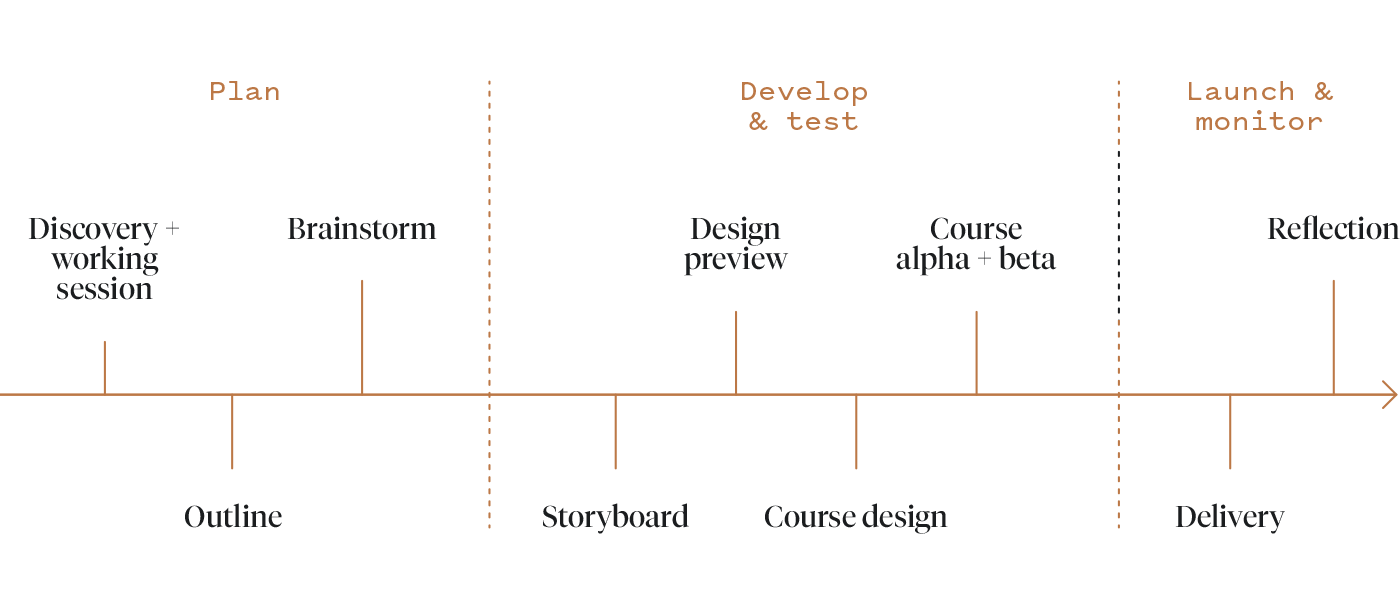
Key players in the eLearning development process
Before we dive into the nitty gritty of each phase, it’s essential to outline the players integral to our multidisciplinary team’s eLearning development success:
Learning Strategist – Develops overarching strategy with the client and executes the vision as the project progresses.
Project Manager (PM) – Responsible for overseeing the project, managing timelines, and keeping the project on track and on budget.
Media team – Producers, animators, and filmmakers who create beautiful, high-quality in-course media assets, including videos, animations, and motion graphics.
Quality Assurance (QA) team – Detail-oriented professionals that conduct quality assurance before final delivery.
Design team:
- Instructional Designer (ID) – Best-in-class instructional writers who conduct interviews, digest subject matter, and write all content.
- Visual Designer – Talented creatives that design the visual look and feel of the course according to your brand specifications.
- Interactive Designer – Learning-oriented creatives that build the course and manage all User Experience (UX)/User Interface (UI) elements.
Practices and principles
Our Learning Principles constitute our foundation—the reasons we do what we do and the blueprint for how we do it. But they aren’t the only integral practices and principles guiding us through our eLearning course development process.
Principles
At Maestro, each and every team also has its own set of guiding principles that inform their unique work discipline. These principles are developed and defined by the teams themselves—after all, they’re the experts in their domains. For example, our Design team follows its unique design principles, such as “Uncenter Yourself” and “Make it Special,” while our PM team follows these four project management principles: Cultivate Client Relationships, Elevate Creative Thinking, Trust Your Instincts, and Advocate for Your Team (And Yourself).

But it’s not just our explicitly laid-out principles that make us stand out.
It’s also the way we work.
How we operate
Our principles, practices, and company culture guide us through everything we do, whether that’s developing eLearning or any other learning experience. These principles and processes make for a smooth and transparent undertaking that cultivates a rewarding customer experience. Here’s a quick overview of what it’s like to work with us.
- At Maestro, we don’t believe in silos. We work together ceaselessly as an interdisciplinary team of dedicated learning experts, continuously cultivating trust-driven connections with all of our clients.
- We’re realistic, flexible, and nimble, responding and adapting to any problems that arise throughout the eLearning development process with calmness and resourcefulness.
- We do sweat the small stuff, attending to even the tiniest of details to ensure your bespoke eLearning course is perfectly suited to your unique needs.
- We’re passionate about innovating and achieving more, putting in the work to surpass your already-high expectations and fulfill your L&D vision.
- While we have a general ideal timeline for executing eLearning experiences, we understand that many factors can impact timelines. Our learning products are custom and tailored to your organization, and we partner with every client to understand their needs, timelines, and how we can achieve the best success together.
Now that you know everything you need to know before entering into the Maestro eLearning course development process, let’s dive into the specifics.
Maestro’s step-by-step eLearning development process
An important part of our process is determining the right deliverables to meet your learning goals—if that deliverable is eLearning, here’s an overview of what you can expect from our eLearning development process.
Discovery and working session
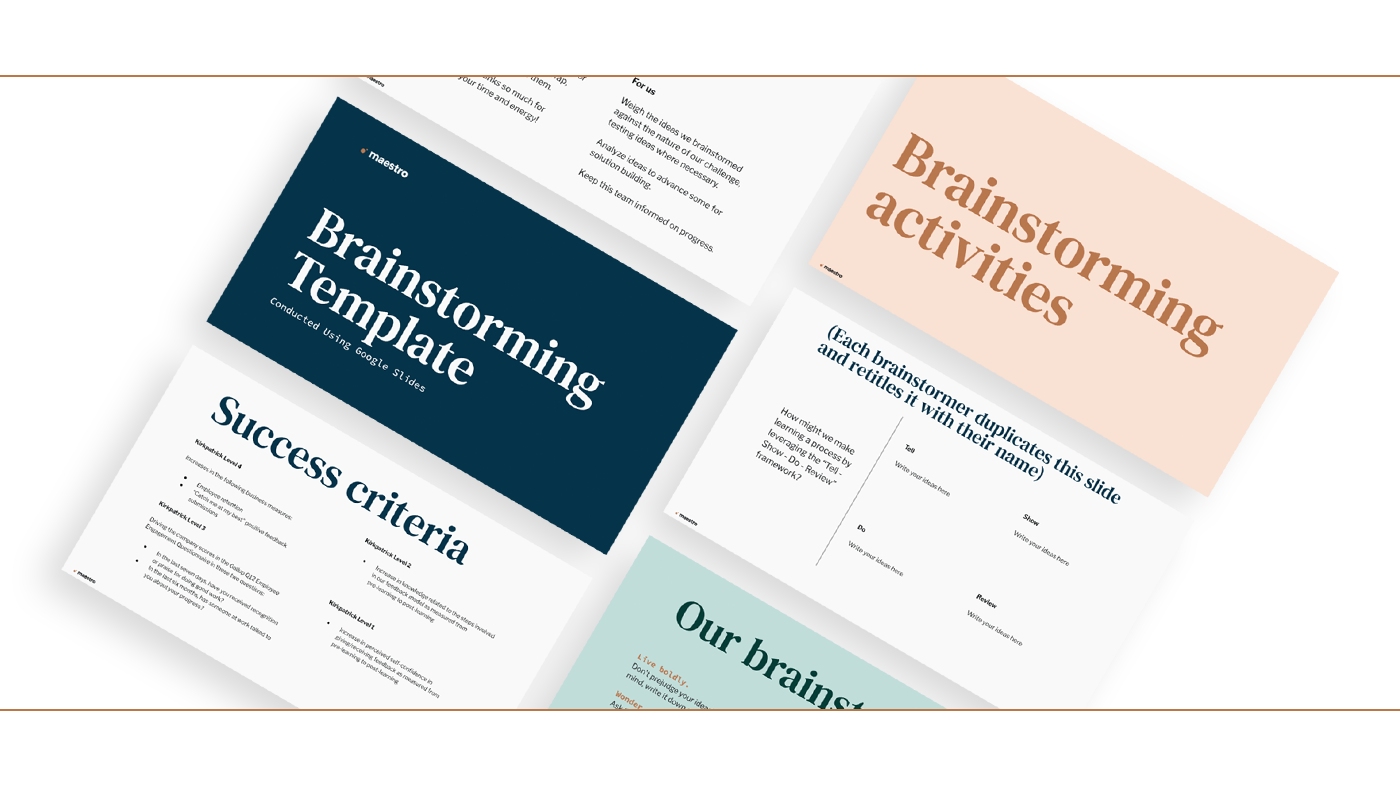
This phase tees up the entire process while helping ensure we’re all on the same page.
Key steps
- Review existing client materials
- Subject Matter Expert (SME) interviews
- Working session
First and foremost, we discover everything we need to know (and more) about you, the client.
Our team reviews relevant materials, studies your brand identity, and gains invaluable insights that will guide our future decisions.
We’re well aware that we can’t possibly be more of an expert on your content than you are! And we own that, which is why we conduct thorough SME interviews and put in extensive work to review existing content and learn the material inside and out.
During this stage, we’ll also have our foundational working session. This marks the first time most of our team members hear directly from the client while setting the tone for the whole eLearning course development project.
Here, the entire team listens, asks clarifying questions, and brainstorms collaboratively. We present our transparent and organized process. And weekly or bi-weekly live client connects—which our clients often call their favorite meeting of the week—begin here and continue through delivery.
The Maestro magic: Genuine relationships
Our multidisciplinary and multifaceted process has an information-rich, genuinely collaborative, and authentically inspired foundation.
But that’s not all.
Throughout this first step, we really build personal relationships—an essential ingredient in the special Maestro sauce. We don’t simply take orders and develop a traditional vendor relationship—one that just throws non-strategic solutions at the wall in the hope that something will stick. Instead, we till the seeded soil and allow a true partnership to grow. Our clients often call us up when they’re stuck on a learning challenge or need a sounding board—and we always answer.
Outlining and storyboarding
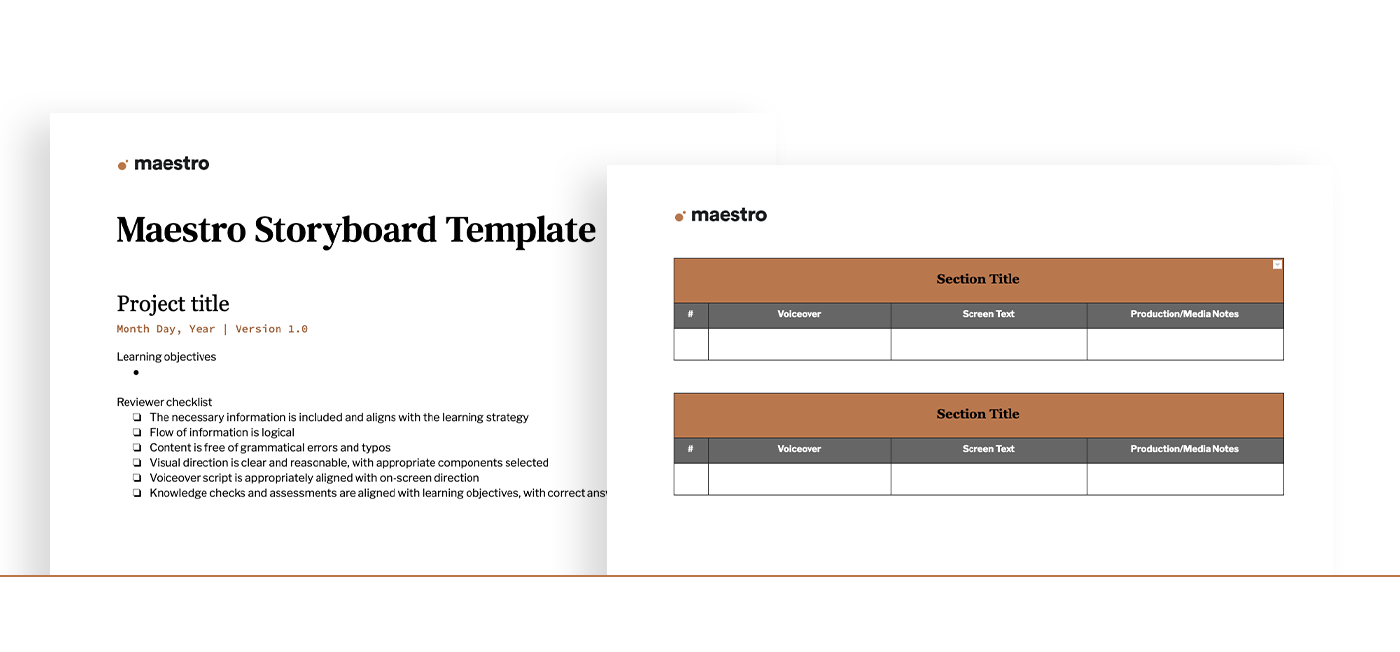
The outlining and storyboarding steps set the stage for the production and development phases soon to come. These steps are critical for getting aligned on content details and design direction. We use Google Docs every step of the way to maintain a collaborative and streamlined review process.
Key steps
- Outline drafting
- Storyboarding drafting
Outlining
In this phase, our IDs use the information we gleaned in the working session to create a first draft of the outline. Then we achieve alignment on the framework, structure, order of content, and featured topics for our eLearning course before getting too far into the project.
Next, we conduct more brainstorming with our entire internal creative team. Our multidisciplinary team focuses closely on the learning problem at hand, developing ideas for a course experience that will best serve learners. We approach the eLearning development process from a highly informed perspective, one that emerges from our Learning Principles and incorporates learning theory, instructional-and-visual-design expertise, and integrates an array of innovative modalities.
As a result, our approach and strategy are defined and finalized, and our whole design team is on the same page regarding what to expect. Then we send the draft to the client for review, validation, and feedback.
Storyboarding
Much of the pre-storyboarding work happens in the discovery phase, especially when the subject matter is complex or highly technical. But once the researching and brainstorming activities are complete, we begin storyboarding in a shared Google Doc with our tried-and-true template.
16 Key Questions to Ask a Potential Learning Partner
In this guide, 16 Key Questions to Ask a Potential Learning Partner, we’re sharing the most important areas to discuss with a potential partner to help you decide if they’re the right fit. We’re delving deeper than the typical checklist and sharing ideas and questions you likely haven’t considered before so you can find a partner who really gets it (and you).
Get the free guide→Throughout this step, we internally review everything from a myriad of unique disciplines and perspectives, discuss specs, and work collaboratively every step of the way.
More specifically, an ID writes a storyboard draft that defines content, tone, and target audience characteristics. One of our visual designers reviews it, making sure the design and production suggestions are feasible. The learning strategist reviews it, referencing the overall vision to make sure the content is solving the problem we’re intending to. The PM also reviews the storyboard, keeping in mind client needs, logistical nuances, and branding specifics.
The thorough IR completed by our entire internal project team helps ensure a squeaky-clean final product. When the time comes, we send the storyboard to the client for review so they can validate all of the details, make change requests, and ask questions.
The Maestro magic: Sharpening your ax
Everyone’s always eager for the design phase to begin, but we know from experience that it’s key to get the outline and storyboard right before going further into the eLearning development process. By identifying the optimal content and structure, and conducting a rigorous, multidisciplinary internal review, we emerge with a robust blueprint for the course—in other words, we do the heavy lifting for you.
All in all, this phase represents our obsession with checks and balances; our belief that everyone should have a role in “owning” each project. It also helps ensure that we’re delivering with exacting quality; designing the right thing and designing things right.
Our tried-and-true process in this early stage is why we’ve been able to successfully tackle eLearning module development and entire course creation on complex topics ranging from Bitcoin trading to the inner workings of complex medical imaging devices.
Design
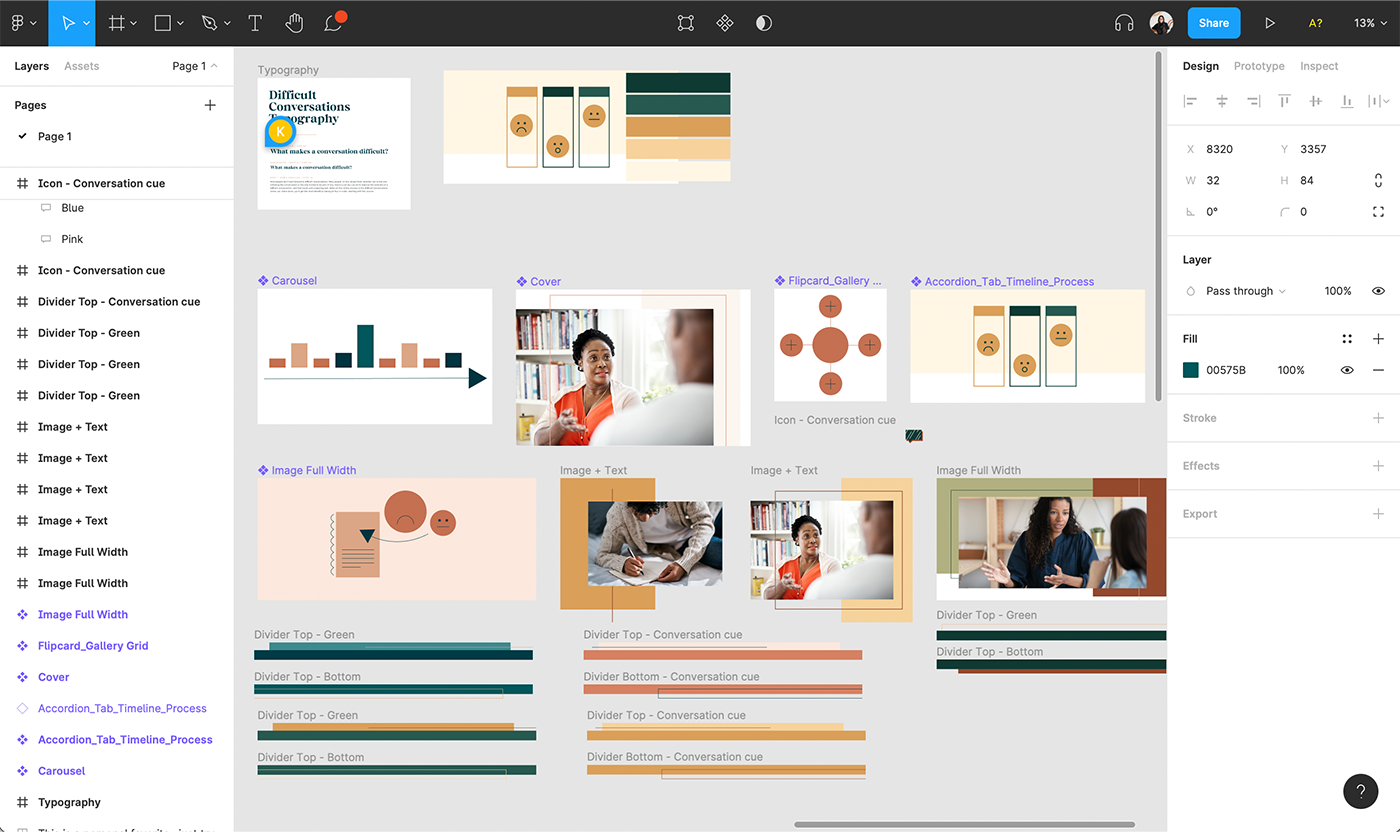
The fun continues in the design phase, an innovative rapid elearning procedure that culminates in a design preview.
Key steps
- Design preview
- Begin voiceover (VO) recording
Our incredible designers start bringing our carefully constructed plans to life, elevating ideas and concepts while tirelessly tailoring everything to the client vision. First, they create a moodboard in FigJam to determine the visual look and feel of the course and review it with the client.
Then the real design preview work begins. Our Design team builds key course elements in Figma first, in order to activate our creativity, design freely, and push ourselves beyond the limits of what an authoring tool (for us, that’s typically Articulate Rise or Storyline) alone can do.
Next, our team starts designing the preview in Rise or Storyline, through a creative and cooperative process. This preview might be the first chapter of the course or a collection of branded components. Think knowledge checks, scenarios, and drag-and-sort activities. (Pssst! Do you love Articulate Rise as much as we do? Then you’ll love Mighty, our Chrome extension for doing more in Rise. Ditch the hacks and workarounds—Mighty does it all for you! Learn more here.)
Once the design preview is done, the client can review it and easily provide feedback. They will also have the opportunity to evaluate it alongside the final storyboard to see the course taking shape from both content and visual perspectives.
The PM, the Strategist, and the Design and Media teams all play significant and collaborative roles in this phase. And as soon as it’s complete, we start working on the VO recording.
The Maestro magic: Innovative capabilities
Because we have the capability to build a diverse range of learning and eLearning solutions—unlike many traditional partners—we have a better capacity for determining and creating the best solution for each kind of learning challenge. If all you have is a hammer, everything looks like a nail—but we have every solution at our fingertips as we design, so we don’t have to resort to simply throwing one type of solution at every problem.
We create our design preview through a multi-step and multidisciplinary design approach, pulling in the right tools to unleash creative freedom. We do this because Articulate Rise and Storyline are incredible tools, but limited with pre-designed authoring elements—we’re committed to pushing our courses beyond the typical cookie-cutter look. We’ve learned to push the bounds of Articulate tools, to consistently create things others thought were impossible, and better satisfy our clients’ steepest aims.
Past clients have been blown away by the brand and content-specific insights we’ve already gleaned at this point in the process, illustrating our experience when it comes to executing rapid eLearning development procedures designed to make your life easier. This is because as with storyboarding, we’ve already completed tons of “homework” before we arrive at this phase.
To sum up, this entire phase gives our brightest creative minds space to shine while helping us stay on track toward creating our shared vision.
eLearning development process
The development phase represents the real meat of our forward-thinking agile course development process.
Key steps
- Alpha course design
- Beta course design
- Finalize course design
In development, we build our Alpha course, or the first iteration of the final eLearning course.
Although our Interactive Designers are leading the charge during this step, it’s a team effort to get to the finish line. Our designers and IDs are having conversations behind the scenes and the full project team is checking in weekly to support one another and work through barriers. It’s all hands on deck and the end result is better for it.
The Alpha course represents the first time anyone on the team gets to see all of our hard work come to life. Once it’s done, we conduct our robust IR once again, having the ID and learning strategist evaluate the course to ensure we’re working in the right direction. We play with the course based on that review, tweaking it and adjusting things to (near-)perfection.
Then we begin the client-review process. We offer a general overview, explain how to make comments in line with the content, and, when necessary, incorporate a live touchpoint.
Finally, we enter the Beta course phase, or the second iteration of the course. We incorporate all of the feedback, make edits, and go through the review cycle again. Finally, the client reviews the course once more and we make final changes before packaging it.
The Maestro magic: Operational excellence
Throughout this step, our internal teams always maintain top-notch quality and the highest standards possible. We do this by focusing closely on client priorities while developing the course, consistently cultivating two-way communication channels, and ensuring that the client’s thoughts are always heard and incorporated.
Our agile eLearning development philosophy is client-forward, so we do everything we can to provide maximum time for you and your team to review each version of the course.
Hey, you’re the client, and this course is for your team. That’s why we pay such close attention to your feedback while keeping our reviews quick; to maintain momentum, fulfill your unique L&D goals, and get your custom course to you ASAP. Our team has a vested interest in meeting your needs and helping your learners succeed—in short, we care.
Delivery and reflection
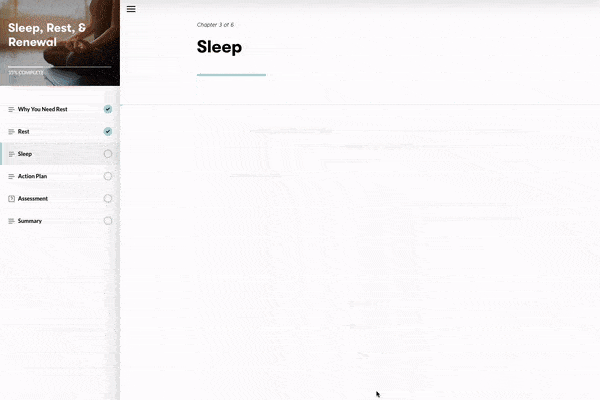
Last but certainly not least … we deliver your eLearning course!
Key steps
- Deliver final materials
- Reflection
The project culminates in the final delivery.
We ship the eLearning course along with other materials. This package usually includes a SCORM package, final assets, and the storyboard. At this point, we’re also available to support rollout, implementation, and tracking results. And oftentimes, we’re also already discussing future projects and goals with the client.
After the client gets the materials, we conduct a reflection (psst—we do a midway reflection point too!). In this step, we facilitate a live connect with key players and give and receive feedback as part of the project cooldown.
The Maestro magic: Transparency
Our reflection touchpoint allows our teams and yours to understand what worked and what could’ve been better throughout the eLearning development process. It enhances future collaborations, provides invaluable insights, and allows for closure on the project. Transparency is important!
We’ve found that this step sets the stage for a rewarding successful long-term partnership while helping us put some of the characteristics we value most—empathy, attentiveness, adaptability, and flexibility—into practice. It also gives us all an opportunity to recognize all the behind-the-scenes yet essential work that oftentimes goes unnoticed.
A principled approach to learning
Creating great learning experiences is no simple task. And eLearning courses—as well as eLearning development processes—are not created equal.
But Maestro’s principled, practiced, and highly strategic approach to the eLearning development process ensures both amazing client experiences and innovative learning experiences that truly deliver. Our strong foundation produces a consistently collaborative, rewarding process. We believe in tracking results, proving behavior change, and iterating so that we’re always outdoing ourselves. And in turn, that process produces eLearning courses that can fulfill all of your loftiest L&D goals.
You undoubtedly want a learning partner with deep expertise and capabilities in learning strategy and design, operational excellence, and creative internal and external collaboration. And it’s a sweet bonus if that partner is fun to work with, right?
Maestro checks all of those boxes. We also work tirelessly to build new boxes, allowing you to look toward the future and reimagine the possibilities of what L&D can do.
Curious what results great eLearning can inspire?
Check out the global onboarding program we created for Royal Caribbean and the inspiring change we achieved together.
View the case study→